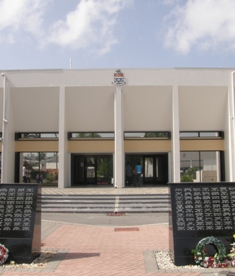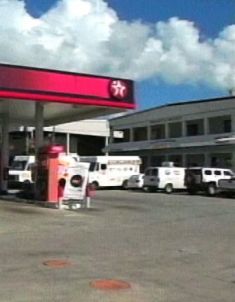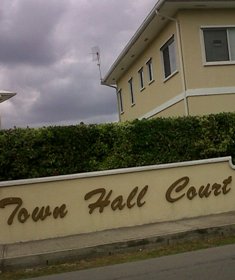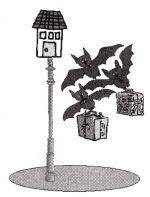Archive for April, 2010

Teen defendant denied bail
 (CNS): The sixteen-year-old boy accused of murdering Marcos Mauricio Gauman Duran has been refused bail, despite requiring specialist treatment as a result of a severe gunshot wound the teen received on the night that Duran was killed. The teenager, who cannot be named as he is underage, appeared before Chief Magistrate Margaret Ramsey-Hale this morning, when his lawyer, Lloyd Samson, continued the teen’s bail application. In receipt of documentation supplied by both the defence and the crown, which has objected to the bail, the magistrate refused the bail application.
(CNS): The sixteen-year-old boy accused of murdering Marcos Mauricio Gauman Duran has been refused bail, despite requiring specialist treatment as a result of a severe gunshot wound the teen received on the night that Duran was killed. The teenager, who cannot be named as he is underage, appeared before Chief Magistrate Margaret Ramsey-Hale this morning, when his lawyer, Lloyd Samson, continued the teen’s bail application. In receipt of documentation supplied by both the defence and the crown, which has objected to the bail, the magistrate refused the bail application.

Local firm makes bid for Asian business
 (CNS): Newly formed Cayman Islands boutique law firm, Thorp Alberga is making a concerted bid for business in the Far East with the opening of a Hong Kong office and the appointment of two new partners. These latest moves are part of what the firm called an aggressive push by Thorp Alberga designed to challenge the major legal players in the offshore world. Richard Thorp and Harriet Unger, formerly with Maples and Calder, will lead the Asian practice.
(CNS): Newly formed Cayman Islands boutique law firm, Thorp Alberga is making a concerted bid for business in the Far East with the opening of a Hong Kong office and the appointment of two new partners. These latest moves are part of what the firm called an aggressive push by Thorp Alberga designed to challenge the major legal players in the offshore world. Richard Thorp and Harriet Unger, formerly with Maples and Calder, will lead the Asian practice.

Local charities facing cuts
 (CNS): According to the 2009/10 budget documents, the government handed well over $10 million in official contributions to the arts, churches, charities and sports associations. The amounts range from as little as $5,000 given to Big Brothers and Big Sisters to as much as $200,000 to the Land and Sea Co-op. From $50,000+ stipends to a number of individual athletes to $60,000 for the Cayman Islands Sailing Club, the government contributes to a wide array of local causes and clubs. There are concerns now from some organisations, however, that their contributions will be either dramatically reduced or cut altogether as the public sector is forced to cut its own budgets.
(CNS): According to the 2009/10 budget documents, the government handed well over $10 million in official contributions to the arts, churches, charities and sports associations. The amounts range from as little as $5,000 given to Big Brothers and Big Sisters to as much as $200,000 to the Land and Sea Co-op. From $50,000+ stipends to a number of individual athletes to $60,000 for the Cayman Islands Sailing Club, the government contributes to a wide array of local causes and clubs. There are concerns now from some organisations, however, that their contributions will be either dramatically reduced or cut altogether as the public sector is forced to cut its own budgets.

Cops make major drug haul in West Bay bust
 (CNS): Police have now confirmed that they have arrested a 23-year-old man following a drugs operation that took place in the West Bay area on Friday morning (9 April). The RCIPS said that at around 7:00 am officers seized a large quantity of ganja from a car in Glade Drive, West Bay. The suspect was arrested on suspicion of possession of ganja with intent to supply and consumption of controlled drugs. Police have not revealed the size of the haul but sources say hundreds of pounds of the illegal drug were found in the boot of the vehicle. Police said that enquiries into the drug haul continue.
(CNS): Police have now confirmed that they have arrested a 23-year-old man following a drugs operation that took place in the West Bay area on Friday morning (9 April). The RCIPS said that at around 7:00 am officers seized a large quantity of ganja from a car in Glade Drive, West Bay. The suspect was arrested on suspicion of possession of ganja with intent to supply and consumption of controlled drugs. Police have not revealed the size of the haul but sources say hundreds of pounds of the illegal drug were found in the boot of the vehicle. Police said that enquiries into the drug haul continue.

Burglars target gas stations and clean out safes
 (CNS): Police have confirmed that three Texaco stations were hit by burglars over a three-day period last week between 7 and 10 April. On the 7 April the burglars attempted to rob the Texaco on Shedden Road in George Town, but after damaging the door an alarm deterred the criminals. However, on 9 April burglars cut the telephone lines at the Crewe Road Madec Texaco and made off with an undisclosed some of money from the safe. Then again on 10 April communication lines were cut to the Texaco Station in Savannah before burglars broke into the property and removed not just the contents but the safe itself.
(CNS): Police have confirmed that three Texaco stations were hit by burglars over a three-day period last week between 7 and 10 April. On the 7 April the burglars attempted to rob the Texaco on Shedden Road in George Town, but after damaging the door an alarm deterred the criminals. However, on 9 April burglars cut the telephone lines at the Crewe Road Madec Texaco and made off with an undisclosed some of money from the safe. Then again on 10 April communication lines were cut to the Texaco Station in Savannah before burglars broke into the property and removed not just the contents but the safe itself.

Crown opens stalled gun trial
 (CNS): Some six weeks after the trial of Keith Orrett, Brian Borden, Bjorn Ebanks and Keith Montaque for possession of unlicensed firearms was adjourned owing to a combination of delays caused over jury problems and issues relating to both the crown and the defence cases, Trisha Hutchinson finally presented the prosecution’s case on Monday morning (12 April). The jury of only six – four women and two men — finally heard the details of the crown’s case that the men were at a house in Town Hall Court, West Bay, when police found two unlicensed loaded shotguns on the afternoon of 7 April 2008.
(CNS): Some six weeks after the trial of Keith Orrett, Brian Borden, Bjorn Ebanks and Keith Montaque for possession of unlicensed firearms was adjourned owing to a combination of delays caused over jury problems and issues relating to both the crown and the defence cases, Trisha Hutchinson finally presented the prosecution’s case on Monday morning (12 April). The jury of only six – four women and two men — finally heard the details of the crown’s case that the men were at a house in Town Hall Court, West Bay, when police found two unlicensed loaded shotguns on the afternoon of 7 April 2008.

Last call to remove bats before end of season
 (CNS): Bats living in roofs are always insect-eating species – not fruit bats – and each one eats up to 2,000 per night, as well as playing an important role in plant pollination, so if you find these harmless creatures in yourroof, don’t think of them as pests but as critical components to the Cayman ecology. If you have bats in your building they can only be moved out of buildings safely until mid-May when baby bat pups are born, so now is the time to call for help. Volunteers at the Bat Conservation Program say you can call them if you need help removing bats permanently and humanely, at 916-6784, the Wildlife Hotline at 917-BIRD, the National Trust at 749-1121 or contact info@caymanwildlife.org Bats not out before the deadline cannot be properly removed until November.
(CNS): Bats living in roofs are always insect-eating species – not fruit bats – and each one eats up to 2,000 per night, as well as playing an important role in plant pollination, so if you find these harmless creatures in yourroof, don’t think of them as pests but as critical components to the Cayman ecology. If you have bats in your building they can only be moved out of buildings safely until mid-May when baby bat pups are born, so now is the time to call for help. Volunteers at the Bat Conservation Program say you can call them if you need help removing bats permanently and humanely, at 916-6784, the Wildlife Hotline at 917-BIRD, the National Trust at 749-1121 or contact info@caymanwildlife.org Bats not out before the deadline cannot be properly removed until November.
According to the BCP, to find out if there are bats in your building, go outside at dusk, just after sunset, but while the sky is still light, and watch. If you see bats emerging, do not plug the hole. Plugging holes can trap bats inside, forcing them into your living areas. Bats can be sealed out (not in!) using simple methods and volunteers are available to advise and/or recommend qualified professionals to assist.
Bats give birth to only one pup per year. Bat-pups cannot fly for several months and remain in the roost while their mothers go out to catch insects. For this reason, exclusions are not done during the summer when these flightless young are present. Often people don’t realize that they have bats in the roof until summer when they hear the young ones squeaking as the mothers return to nurse them in the quiet pre-dawn hours. To avoid the long waiting period, the Bat Conservation Program is hoping to reach everyone with this message in time so that bats can be moved before the mid-May deadline.
“Bats are harmless. Each one eats up to 2,000 mosquitoes and other insects, including crop and garden pests, every night. But, they should still be moved out of roofs to avoid odour problems. We want to help get bats out of houses and calm fears,” said Lois Blumenthal, Coordinator of the Caribbean Bat Conservation Project for Bat Conservation International (www.batcon.org) and Director of the Bat Conservation Program for the National Trust. “Our goal is for all bats to live in bat houses and no more bats in roofs.”
With the cooperation of Caribbean Utilities Co Ltd (CUC), Ron Moser’s Machine Shop and extensive volunteer labour, there are over 80 bat houses in all districts of Grand Cayman. They provide alternative habitat to help to keep bats from moving into roofs. Bat houses are a great success but bats won’t move out of roofs without an exclusion.
Bats are part of the balance of nature and helpful to humans in many ways, notably, the control of insects but they are also important pollinators and seed dispersers. Bats living in roofs are always insect-eating species. Fruit bats have never been found in roofs here and do not use bat houses. Bat houses can only provide habitat for three of the Cayman Islands’ nine species. The other bat species need forest and cave habitat to survive.
For free information, a map of Cayman Islands bat house locations, photos of local bats, or to download an educational slide show about the Cayman Islands Bat Project, visit www.caymanwildlife.org The National Trust Educational Program Manager visits local schools with a presentationabout Cayman Islands Bats and free information is also available on www.nationaltrust.org.ky
Teen charged with murder
(CNS): Updated 2:30 pm. A 16-year-old boy arrested last month in relation to the fatal shooting of Marcos Mauricio Gauman Duran appeared in court this morning charged with the murder. The teenager arrived at court on crutches as a result of a gunshot wound he received on the night the crown alleged the youngster killed Duran. Represented by Lloyd Sampson, the teenager, who cannot be named for legal reasons, was seeking bail because of his need for specialist care as a result of his severe leg injury. Samson also suggested the young boy would be at risk if he were to be held in custody at Eagle House. The crown objected on the grounds of the seriousness of the offence but Magistrate Margaret Ramsey-Hale deferred the bail hearing in lieu of more information.
Samson said he had concerns about the cogency of the crown’s case as he said that while his client’s DNA may have been found at the scene, there was no evidence that the teenager committed any crime.
The crown, however, alleges that the young man went to the address in Maliwanas Way, West Bay, on Thursday 11 March to rob the deceased. During the incident the defendant received a gunshot wound and left blood at the scene before he made his escape to Birch Tree Hill Lane from where a call was made to the emergencies services reporting his injuries, the prosecution said.
The teenager, who is still receiving treatment after major surgery, was arrested on Thursday 8 April in relation to the murder and was charged with the crime this morning (Monday 12 April.)
Samson told the court during the bail application that his client was not a flight risk, not least because of his condition but because he also had family support. The lawyer said his client was a candidate for an electronic monitoring device. The magistrate remanded the teen in custody overnight as she deferred the matter until tomorrow morning.
Duran, an Ecuadorian national from George Town, was killed as he was visiting an apartment on Maliwinas Way and was the third murder victim of 2010.

Man charged with teen rape
(CNS): Jeffrey Barnes (30) has been charged with abducting and raping a 16-year-old girl and is expected to appear in court today. Police say that, shortly after midnight on Tuesday 30 March, a 16-year-old girl reported to police that she had been sexually assaulted by a man who had offered her a ride home from a bar in the Mary Street area of George Town. The man, instead of taking her home as agreed, had taken her to an isolated beach location and raped her.
Barnes, a Caymanian from the George Town area, was arrested the next day, the 31 March. He has now been formally charged with rape, abduction, threatening violence and is expected to appear in court later today, Monday 12 April.

Cayman’s children and the Catholic Church
For God’s sake, what is it going to take? How many more horrible stories must we see in the international news before someone in the Cayman Islands takes a good look into the safety of our children who are involved with the Catholic Church here? Wasn’t the report about the priest who molested approximately 200 deaf boys at a boarding school in Wisconsin the final straw?
Or what about last week’s revelation that Cardinal Ratzinger, who later became pope, appears to have sided with that monstrous priest over the child victims?
Given the ever-growing scandal of rampant sexual abuse of children and teens by Catholic priests, it is absurd for us to pretend that it could never happen in the Cayman Islands. It may already have happened. Who would have told the public if it had? Who would have warned parents if a priest had come here under a cloud of accusations and past crimes? Certainly not the Church.
Defenders of the faith are likely to cringe in horror at such comments. After they finish cringing, however, they may want to consider who oversees Cayman’s St. Ignatius Parish. The Archdiocese of Detroit has pastoral responsibility for Cayman and this is their record: Sixty-three of their clerics sexually abused 116 victims over the past 54 years. This is what is on record. No one knows what the real toll might be. Bad as that is, however, consider these findings from an in-house national review board: In the US, from 1950 to 2002, more than 4,000 priests and deacons have sexually abused nearly 11,000 American children. A more recent report, dealing with the period from 2004 through 2009, identified 3,091 “abusive clergy” and 4,568 victims. These are astonishing numbers alone. However, they are even more striking since they are attached to an organization that claims to occupy humanity’s moral high ground.
Perhaps the only thing more disgusting than so many priests sexually abusing so many children and teenage minors is the way Catholic leadership reacted to the crisis. The institution that once ran inquisitions and burned women at the stake seems very forgiving of sin when the sin involves their priests molesting children. Rather than pick up the phone and call the police like any normal and decent human being would do upon learning that a child has been raped, Church leaders often chose to hush it up and simply transfer offenders to new hunting grounds where they could continue preying on children. Therefore, it is not rude or unreasonable to openly wonder if any predator priests were sent to the Cayman Islands over the last 60 years. (For most of that period Cayman was under the leadership of the Kingston Diocese. The Arch Diocese of Detroit took charge of the Cayman Islands in 2000.)
In addition to the past, there is the present and the future to consider as well. Someone here should be asking hard questions, doing background checks, and—if all is well—reassuring the public that there is nothing to worry about. In the absence of that, based on what we see in the international media every day, shouldn’t St. Ignatius Church have a warning sign posted on its property at the very least?
Here’s a discomforting thought for Cayman’s Catholics to ponder when they put their hard-earned money in the collection plate this Sunday. So far, the US Catholic Church has paid out some $3 billion to victims who were sexually abused by clergy.No doubt, as more cases come emerge around the world, many more settlements will have to be paid. One wonders why good people are content to help pay for the evil deeds of others.
To be clear, nothing in this commentary should be misinterpreted as an accusation against any individual priest in Cayman, past or present. Everyone is innocent until proven guilty, of course, and the majority of priests are decent people who would never harm a child. Child molesters can be found in any profession. However, when an employee is caught having sex with children or minors, most companies and institutions have the good sense to fire them immediately and report it to the police. Or, at the absolute minimum, make certain that this employee is not allowed to be around children anymore. Most CEOs definitely would not react by simply transferring the offender to another region, as the Catholic Church did in numerous cases. The key message here is that the Catholic Church itself, the entire global entity, has shown that it cannot be trusted with children.
Catholics may be interested to know that some non-Catholics are genuinely confused by the Church loyalties of so many mothers and fathers. Why would any parent continue to involve their child in an organization with a record like this? Just imagine if some Cayman organization or company had a similar international scandal, one involving years of abuse by a significant number of its mid-level managers, blatant cover-ups by top executives, and big payoffsto victims. They probably would have been shutdown long ago. One would think that our government would be very interested in their activities here. It would also be reasonable to assume that no right-thinking Caymanian parent would allow their children to go within a mile of their property, right? So why is it different with the Catholic Church? Why don’t “better safe than sorry” and “I’ll do anything to protect my child” apply in this context?
Imagine if one of our local fast-food franchises was connected to a pattern of abuse and cover-up that extended up to the highest levels of management. What if the scandal involved several countries and, from 2004 through 2009, 3,091 of their employees were known to have sexually abused 4,568 child victims? Would you continue to give this company your money and eat their food? Would you let your child work there?
Before local Catholics circle the wagons and misinterpret this commentary as a mean-spirited attack against them, one hopes they will consider what really matters here. This is about children. This is not a grumpy tirade by a bitter ex-Catholic with an axe to grind. These are not the ramblings of some nut who thinks the Pope is the Anti-Christ. This commentary is only pointing out that there is clear reason to be concerned about the safety of our children, nothing more. Hopefully, sensible Catholics who love their children will recognise this and agree.
No one in Cayman can deny that the warning has been sounded loud and clear. So many US cases have been reported in print, on radio and on TV that it feels routine. Now the scandal has grown to include Ireland, Germany, Spain, Austria, Netherlands, and other countries. This is not a US problem, as the Vatican once claimed. Clearly it is a Catholic problem that national borders do not contain. There is nothing so special about the Cayman Islands to suggest that it could not have happened here or that it could never happen here.
If it ever comes to light that even one Caymanian child has been sexually abused by Catholic clergy in recent years, or at any time in the future, the guilt will extend far beyond church grounds. As a society we would have no excuses to hide behind. None of us would have the luxury of feeling surprised or shocked. This problem has been on the radar since at least the 1980s and should be common knowledge by now. The story is out and it’s everywhere: the predator priests, cardinal cover-ups, and the Vatican unwilling toact decisively in the interest of children. If it happens in Cayman, we certainly can’t say that it snuck up on us.
A recent letter sent to Catholic leaders from past victims of clergy abuse in the Pacific island of Guam pleaded for accountability and safeguards against future abuse. It contained the following line: “We fear for the children of Guam.”
One wonders about the children of the Cayman Islands. Does anyone here care enough to fear for them?